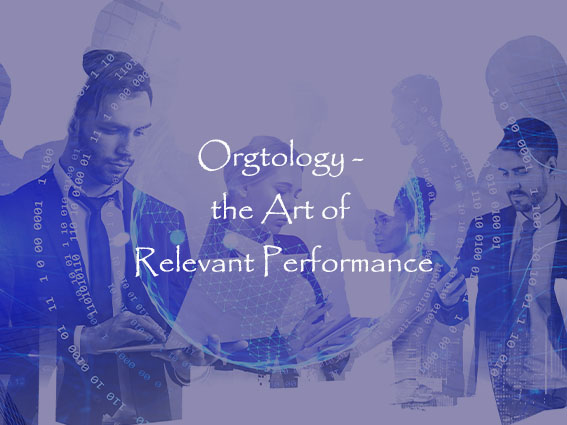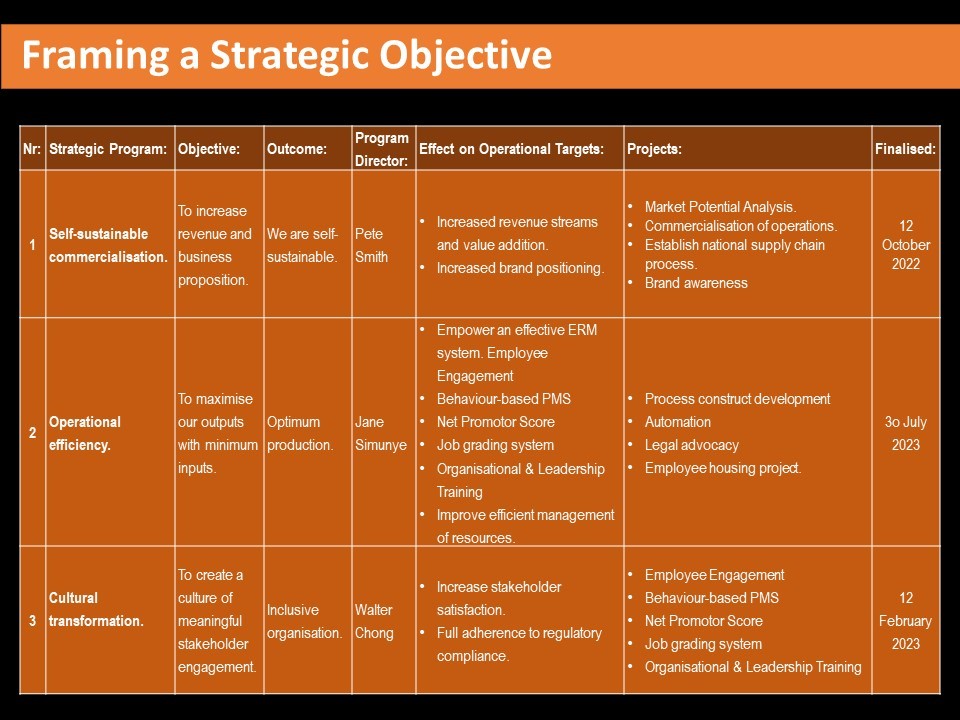The Orgtology Blog
Defining Strategic Effectiveness - an Orgtology Perspective
Strategic effectiveness begins by knowing what to change. This is a complex process of understanding both a current reality and a desired state. Its not just about changing. Firstly, it is about knowing where we are. Secondly it is about knowing why we want to change. Thirdly it is about what must change. Lastly, it is about whether we are strong enough to survive such change if things should go wrong.
To be strategically effective, we must anticipate the future in the most specific way possible. It begins though knowing exactly what to change and then creating a work-breakdown structure (WBS) for that. I explain the WBS in another write-up. The aim of this essay is to understand and define the change.
Basic assumption on strategic effectiveness
If the purpose of strategy is to keep Org relevant, then strategic effectiveness is the art of doing the right things. If we do the right things, then Org will hold a favourable and sponsored position within its operational environment. That is what makes strategy effective.
To do the right things, Org must first have a realistic understanding of its operational environment. We use the REET analysis for this. Secondly Org must have a clearly defined future. We use the 5V Model for that. To remedy operational inefficiencies and to ensure future survival we develop strategic objectives that will drive the change that we need. We then execute these objectives via program and project management methods.
The role of REET in strategic effectiveness
We understand the health of an operating environment through assessing its relationships, effectiveness, efficiency, and threats. In orgtology, this is known as the REET analysis.
I have designed the REET around Hypothesis 2x, which means that we understand projective and receptive elements in distinct ways. We do so, since the rules for running and changing a business are not the same. To run a business is a matter of performance, whilst changing a business is a matter of relevance. The former is mathematical, predictable, and can mostly be automated. The latter is abstract, unpredictable, and driven by human intent.
REET helps us to understand which processes to remedy and what projects to engage with. Yet, REET is not enough to guide strategic direction. It plays a large part in deciding what strategic projects to engage in. Yet, in terms of what to accept and what to reject, the 5V model reigns supreme…
The role of the 5V Model in strategic effectiveness
The 5V Model is an orgtology tool that we use to create a strategic ladder towards an ultimate dream. It begins by creating an ultimate and non-quantifiable dream. Something towards which we will always strive. We then reverse engineer this dream through four quantified states. The first three states, V2, V3, and V4 will each show the end of a strategic period. E.g., if Org drives a three-year strategy, then V2 will be 9-years from now, V3 = 6 years from now, and V4 will be 3-years from now. In so, V4 will be a focal goal for our current strategy. V5, the last "vision", is a 12-month super goal. I.e., what must change in the next 12-months.
The 5V model works well because it brings vision closer to now. One of the reasons why strategy often fails is because the vision statement is so far removed from current reality that it is difficult to relate strategic activity to the execution of a vision. With 5V we know what to change in the next 12-months to get closer to a far-off future.
Once we have done our REET analysis, we will know what is working and what is not. I.e., we will know what to change. The 5V will help us to understand whether our proposed change will get us closer to a future desired state. In so, V5 will help us drive relevant change.
Finding strategic direction
Strategic direction is knowing which primary areas of Org needs to change. This is a slow process of identifying projects that will remedy current inefficiencies and bring us closer to a desired state. As mentioned, we use the REET and the 5V Model to do this.
Strategic direction would for example be something like: "create a culture of inclusion", "increase our operational efficiency", or "increase our revenue streams". These are all broad areas that direct change and transformation. It is important to not have too much of them. As rule of thumb, I would say that two are too little, and that five is too much.
From an orgtology perspective, we use the following areas as base point. I.e., they are a starting point for thinking about strategic direction…
- Operational efficiency (process efficiency, target setting, risk aversiveness, etc.).
- Strategic effectiveness (communication, sales, market share, etc.).
- Behaviour (culture, values internalisation, etc.).
An Orgtologist will typically assess the generic areas above against the REET findings. This should cover all areas of change within Org. After defining the 5V Model, one will then give shape to the strategic direction, in terms of its wording and associated projects.
Getting practical through strategic objectives
The strategy game plan begins with strategic objectives. These are super goals that we create to change something. We begin defining strategic objectives when we understand what to strategically focus on. We get these focus areas partly from our REET analysis and partly from our 5V Model. Jointly, REET and 5V will help us know what to change and maintain.
As mentioned, when creating strategic focus, we have a default position. These areas cover all aspects of organisational functioning. We must always test our strategic objectives against all three of them. They are:
- Efficiency.
- Effectiveness.
- Culture and behaviour.
A strategic objective differs from a target in that a target measures the cycle of a process, whilst an objective defines the change that must take place. It therefore defines the intent of a project, whilst a target assesses the efficiency of a process. Most strategic documents that I have read fail to distinct these two. In so, they confuse strategic change with operational targets. This makes most strategy documents incredibly operational.
A good strategic objective should always be linked to an effect. This gives us a clear beginning and end. The objective will explain our intent, whilst the effect will help us understand what we envisage the change to be. There are also the execution data that we must add. They are the due date, responsible person, etc.
Each strategic objective is then turned into a strategic program, which we run through project management methods. The difference between a program and a project is that the activities of a program are projects. I.e., the program runs a group of projects. In that way strategy is executed through a method that gives precise control.
Figure 12 shows how we define strategic objectives and their contexts. Each project is unpacked via project management methods. I.e., due dates, milestones, critical path, responsible person, etc.
Conclusion
Knowing what to change is one of the most important leadership skills for any organisation. In that sense, the executive team of any organisation are the people who represents to highest risk to Org. If they screw up, the consequence for Org is detrimental.
To reduce this risk, orgtology offers the REET and 5V models. They help us to define change in quite a specific way. It all ends with 2 to 5 strategic objectives. From here the process gets mechanical. I.e., to complete the strategy, we must firstly identify activity and resources. Secondly, we must break down the work through dependency flow, specific responsibility, allocated cost, and clear time boundaries.
Without strategic direction, the relevance of Org is at stake. Without relevance, performance becomes nonsensical. Strategic direction therefore defines leadership.

Join the Orgtologist Certification Program (OCP) - Empowering Executive Teams Worldwide
Copyright
© Derek Hendrikz: 2021-10-24
When you subscribe to the blog, we will send you an e-mail when there are new updates on the site so you wouldn't miss them.



